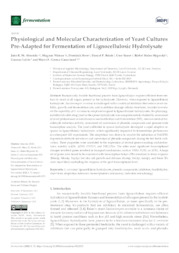Physiological and molecular characterization of yeast cultures pre-adapted for fermentation of lignocellulosic hydrolysate.
Physiological and molecular characterization of yeast cultures pre-adapted for fermentation of lignocellulosic hydrolysate.
Autoria: ALMEIDA, J. R. M. de; WIMAN, M.; HEER, D.; BRINK, D. P.; SAUER, U.; HAHN?HÄGERDAL, B.; LIDÉN, G.; GORWA?GRAUSLUND, M. F.
Resumo: Economically feasible bioethanol process from lignocellulose requires efficient fermentation by yeast of all sugars present in the hydrolysate. However, when exposed to lignocellulosic hydrolysate, Saccharomyces cerevisiae is challenged with a variety of inhibitors that reduce yeast viability, growth, and fermentation rate, and in addition damage cellular structures. In order to evaluate the capability of S. cerevisiae to adapt and respond to lignocellulosic hydrolysates, the physiological effect of cultivating yeast in the spruce hydrolysate was comprehensively studied by assessment of yeast performance in simultaneous saccharification and fermentation (SSF), measurement of furaldehyde reduction activity, assessment of conversion of phenolic compounds and genome‐wide transcription analysis. The yeast cultivated in spruce hydrolysate developed a rapid adaptive response to lignocellulosic hydrolysate, which significantly improved its fermentation performance in subsequent SSF experiments. The adaptation was shown to involve the induction of NADPHdependent aldehyde reductases and conversion of phenolic compounds during the fed‐batch cultivation. These properties were correlated to the expression of several genes encoding oxidoreductases, notably AAD4, ADH6, OYE2/3, and YML131w. The other most significant transcriptional changes involved genes involved in transport mechanisms, such as YHK8, FLR1, or ATR1. A large set of genes were found to be associated with transcription factors (TFs) involved in stress response (Msn2p, Msn4p, Yap1p) but also cell growth and division (Gcr4p, Ste12p, Sok2p), and these TFs were most likely controlling the response at the post‐transcriptional level.
Ano de publicação: 2023
Tipo de publicação: Artigo de periódico
Unidade: Embrapa Agroenergia
Palavras-chave: Industrial microbiology, Lignocellulose, Microarray technology, Phenolic compounds, Transcriptomics
Observações
1 - Por padrão são exibidas publicações dos últimos 20 anos. Para encontrar publicações mais antigas, configure o filtro ano de publicação, colocando o ano a partir do qual você deseja encontrar publicações. O filtro está na coluna da esquerda na busca acima.
2 - Para ler algumas publicações da Embrapa (apenas as que estão em formato ePub), é necessário ter, no celular ou computador, um desses softwares gratuitos. Sistemas Android: Google Play Livros; IOS: iBooks; Windows e Linux: software Calibre.
Acesse outras publicações
Acesse a Base de Dados da Pesquisa Agropecuária (BDPA) para consultar o acervo completo das bibliotecas da Embrapa.

